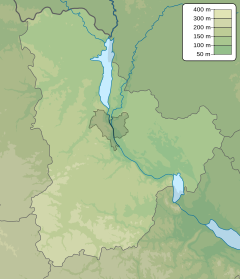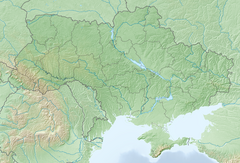Ascension Convent (Kyiv)
| Ascension Convent | |
|---|---|
Ukrainian: Флорівський монастир | |
 The katholikon and bell tower | |
| General information | |
| Location | Kyiv, Ukraine |
| Country | |
| Coordinates | 50°27′45″N 30°30′53″E / 50.46240°N 30.51471°ECoordinates: 50°27′45″N 30°30′53″E / 50.46240°N 30.51471°E |
| Construction started | 1732 |
| Owner | Ukrainian Orthodox Church (Moscow Patriarchate) |
 | |
The Ascension Convent (Ukrainian: Флорівський монастир, Russian: Флоровский монастырь) in the Kyivan neighbourhood of Podil, also known as the Florivsky, originated in the 16th century as the wooden church of Sts. Florus and Laurus. Its buildings occupy the slopes of the Zamkova Hora. Address: vulytsia Frolivska, 8.
History
The convent greatly expanded at the time of the Great Northern War, when Peter the Great ordered the demolition of the old Ascension Convent on Pechersk Hill with the aim of building an arsenal there. When run by Ivan Mazepa's mother, the older convent had amassed much property.[1] Its riches and nuns were transferred to the Florovsky Convent.
The main church, or katholikon, is a notable example of Ukrainian Baroque architecture.[2] Its first stone was laid in 1722. Ten years later, the three-domed building was dedicated to the feast of the Ascension of Christ. Its Neoclassical bell-tower is of later construction.
The wooden buildings of the monastery were entirely destroyed by fire in 1811. Only the katholikon and a 17th-century refectory were left standing amid the ashes. It was Andrey Melensky, a Neoclassical architect from Kyiv, who was in charge of the convent's reconstruction.[1]
The convent's notable residents included Princess Natalia Dolgorukova, one of the first Russian women writers.[1] It was closed in 1929 but reopened after the Germans entered the city in 1941. Several buildings have since been taken over by industrial enterprises.[1]
References
- ^ a b c d Old Kyiv Archived 2013-08-10 at the Wayback Machine
- ^ Памятники градостроительства и архитектуры Украинской ССР
- Webarchive template wayback links
- Articles with short description
- Articles containing Ukrainian-language text
- Coordinates not on Wikidata
- Infobox mapframe without OSM relation ID on Wikidata
- Articles containing Russian-language text
- Convents in Ukraine
- Monasteries of the Ukrainian Orthodox Church (Moscow Patriarchate)
- Religious buildings and structures completed in 1732
- Residential buildings completed in 1732
- Baroque architecture in Kyiv
- Neoclassical architecture in Kyiv
- Podilskyi District
- Neoclassical church buildings in Ukraine
- Pages using the Kartographer extension


